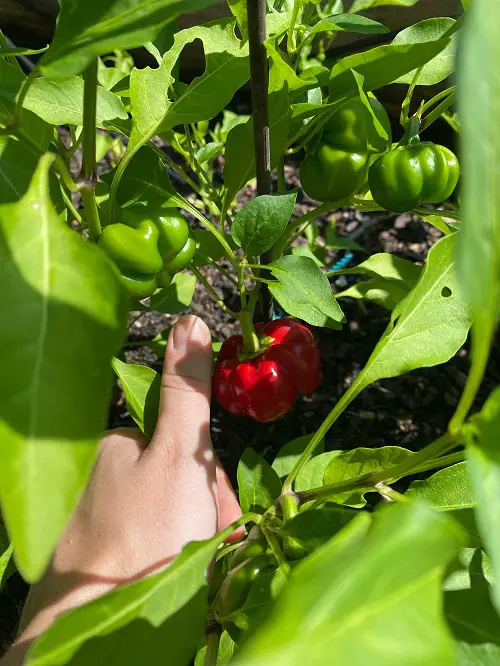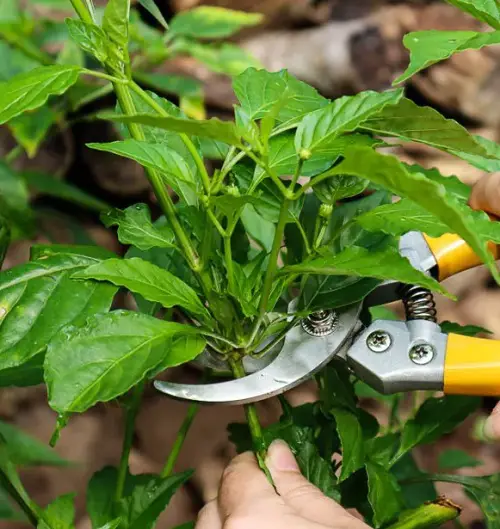Lots of leaves but no fruits? Well, if you prune pepper plants this way, they will reward you with a bumper harvest.

Do you have a pepper plant with lush leafy growth but barely any peppers? Pruning, as we suggest in this article, helps. It’s like giving your plant a much-needed haircut to encourage it to grow more peppers.
Why Prune Peppers? And Is It Necessary?
To prune or not to prune–that’s the big question. Pruning pepper plants can definitely increase your harvest. Here’s how:
- Pruning strategically can redirect the plant’s energy. By removing certain shoots, you can encourage the plant to focus its growth on developing more lateral branches.
- Dense foliage can create a humid microclimate around the plant, which is an ideal breeding ground for fungal diseases. Pruning helps to thin out leaves and stems, allowing for better air circulation.
- When a pepper plant has many leaves and shoots competing for resources, it can produce smaller, less flavorful peppers. Pruning can also help with this.
Well, you know what pruning can do for your plants, but when should you avoid it?
As a rule, avoid pruning compact and ornamental varieties; they only need light pruning.
If your pepper plants are already stressed due to extremely hot or cold weather, have recently been transplanted, or are not getting enough nutrients, wait until they’re healthier before pruning.
Prune Pepper Plants This Way for Maximum Harvest
Now that you know when to pick up the pruning shears and when you shouldn’t, here’s how to prune your peppers to get a better harvest.
1. Top it for a Bushier Plant
First Things First, when your pepper plant reaches 6-8 inches tall, pinch off the top stem just above a node (leaf junction) with 2-3 sets of leaves below to encourage more lateral shoots. This way, you’ll have a bushier plant with more pepper-producing potential.
2. Take Care of the Early Flowers
Also, skip the early flowers. It might be tempting to keep those blooms, but resist! You should pinch off the first few flowers if you want more peppers later in the season. What this will do is it will give your plant some more time to establish the roots.
Pro Tip: Prune on a dry, sunny day to avoid spreading diseases.
3. Time for the Suckers
Once you’ve taken care of the first two, pay attention to the suckers, just like tomatoes, especially if you’re growing heirloom and perennial pepper varieties.
These are the little shoots that sprout between the main stem of the pepper plant and its branches and never flower or fruit.
Most people wait for long, but we recommend pinching off these suckers with your fingers when they’re just tiny nubs. This helps divert some energy into producing fruits.
Remember to wait until your plant reaches about a foot tall and has at least 4 sets of true leaves (not the tiny seed leaves).
4. Remove the Dense and Tangled Growth

Throughout the growing season, you should get rid of any branches that are growing inward and rubbing against others. Actually, these block the airflow, which is important for a pest free pepper plant.
Pruning these will keep your plant healthy and save it from any fungal diseases. Plus, if you ever spot a diseased leaf or branch, remove it so the disease does not spread.
Just make a habit of Micropruning—removing small, unproductive, or undeveloped leaves and shoots that you see in the growth early on. This will help with light penetration, better air circulation, and, of course, plant health and won’t put stress on your specimen.
5. Remove the Late Season Growth
About 3-4 weeks before the predicted first frost date, you should prune unproductive branches–the ones that do not have any flowers or fruits. If you live in frost-free climate, do it in late fall or early winter.
The plant will then focus on forming fruits from flowers and ripening the ones that you already have and won’t waste its energy on vegetative growth.
Simple right? Yes, as long as you prune with care, nothing can go wrong. Whatever you do, do not damage the main stem and never prune more than 20 to 30 percent of the foliage and stems at one time!
Tips to Prune Pepper Plants for Maximum Harvest
- When your plant reaches 6-8 inches tall, nip the growing tip just above a leaf node, as it helps sprout side shoots.
- As the season progresses, within a month before the first frost, give your peppers a final trim and remove any branches that don’t have buds on them.
- Always use clean, sharp scissors to prune, as dull tools can damage the plant and cause unnecessary stress. A clean cut heals faster and promotes healthy growth. Here are 9 more tricks to help you grow a bucket full of peppers.





